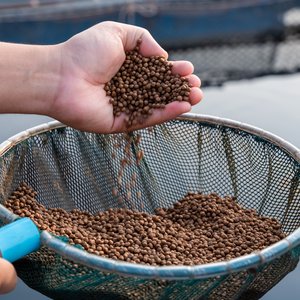U.S. Seafood Consumption Declines Slightly in 2009
The average American ate 15.8 pounds of fish and shellfish in 2009, a slight decline from the 2008 consumption figure of 16.0 pounds, according to a new NOAA Fisheries Service report.
The U.S. continues as the third-ranked country for consuming fish and shellfish, behind China and Japan. In total, Americans consumed a total of 4.833 billion pounds of seafood in 2009, slightly less than the 4.858 billion pounds in 2008.
Shrimp remained the top seafood item of choice for the United States at 4.1 pounds per person, a level unchanged since 2007.
The average 15.8 pounds consumed per person in 2009 was composed of 11.8 pounds of fresh and frozen finfish and shellfish, 3.7 pounds of canned seafood, primarily canned tuna, and 0.3 pounds of cured seafood, such as smoked salmon and dried cod. The overall decline in average consumption per American was due to a decrease in canned seafood consumed.
“With one of the highest consumption rates in the world, the U.S. has the ability to affect the world fish trade,” said Eric Schwaab, NOAA assistant administrator for NOAA’s Fisheries Service. “NOAA supports rebuilding and sustaining wild fisheries populations and building a strong aquaculture program that can help the U.S. fishing industry gain a larger share of the U.S. market. Americans should know that buying American seafood supports our economy, as well as the high environmental and safety standards our fishermen meet.”
Most of the seafood consumed in the U.S. was not caught in U.S. waters. About 84 percent of the seafood consumed in the U.S. is imported, a dramatic increase from the 66 percent just a decade ago.
Farmed seafood, or aquaculture, comprises almost half of the imported seafood. Aquaculture production outside the U.S. has expanded dramatically in the last three decades and now supplies half of the world’s seafood demand, according to the United Nations Food and Agriculture Organization.
America’s aquaculture industry, though vibrant and diverse, currently meets less than ten percent of U.S. demand for seafood. Most of the U.S. aquaculture industry is catfish, with marine aquaculture products like oysters, clams, mussels and salmon supplying less than two percent of American seafood demand.
“This report demonstrates there is room for the U.S. aquaculture industry to grow,” said Schwaab. “NOAA is working to develop a new national policy for sustainable marine aquaculture that will help us narrow the trade gap and strengthen the entire fishing industry in this country.”
NOAA’s Fisheries Service has been calculating the nation’s seafood consumption rates since 1910 to keep consumers and the industry informed about trends in seafood consumption and trade. The information is published every year in NOAA’s Fisheries Service annual report, Fisheries of the United States is now available online.
The entire publication is available for download or you may view individual chapters:
- Cover, Preface, Table of Contents, and Review
U.S. COMMERCIAL FISHERY LANDINGS- Species
- Disposition
- Regions and States
- Ports
- Catch by species and distance from shore
- U.S. Landings for Territorial Possessions
- U.S. Aquaculture Estimated Production
- Top 10 Recreational and Commercial Species
- Disposition
U.S. MARINE RECREATIONAL FISHERIES- Review
- Harvest by species
- Harvest by mode of fishing and species group
- Harvest by distance-from-shore and species group
- Harvest and total live releases by species group
- Finfish harvest and releases by state
- Number of anglers and trips by state
- Harvest by species
WORLD FISHERIES- World Aquaculture & Commercial Catches
- Countries, Continents & Oceans
- Species groups & Disposition
- Imports and exports, by leading countries
- Countries, Continents & Oceans
U.S. PRODUCTION OF PROCESSED FISHERY PRODUCTS- Review
- Value
- Fish sticks, fish portions, and breaded shrimp
- Fillets and steaks
- Canned
- Industrial
- Value
FOREIGN TRADE- Review
- U.S. IMPORTS:
- Principal items
- Edible and nonedible
- Continent and country
- Groundfish fillets and steaks, species & Blocks
- Canned tuna and quota
- Shrimp, country of origin
- Shrimp, by product type
- Industrial
- U.S. EXPORTS:
- Principal items
- Edible and nonedible
- Continent and country
- Shrimp and Lobster
- Salmon and Surimi
- Crab
- Industrial
- U.S. IMPORTS:
U.S. SUPPLY- Edible and nonedible
- Finfish and shellfish
- Blocks, fillets and steaks
- Tuna, fresh and frozen
- Canned sardines, salmon, tuna
- Crab, king, snow, crabmeat
- Lobster
- Clams, oysters, scallops
- Shrimp
- Industrial
- Finfish and shellfish
PER CAPITA- Review
- U.S. consumption
- Consumption by product
- World consumption-by region and country
- U.S. use
- U.S. consumption
VALUE ADDED- FAQ Sheet for the Value Added Table
INDUSTRY INFORMATION- INDEX OF EXVESSEL PRICES
- Review
- PROCESSORS AND WHOLESALERS
- Processors and wholesalers: plants and employment
- FISHERY PRODUCTS INSPECTION
GENERAL INFORMATION- MAGNUSON-STEVENS FISHERY CONSERVATION AND MANAGEMENT ACT (MSFCMA)
- General
- Regional Fishery Management Councils
- Optimum yield, U.S. capacity, reserve, and allocations
- Regional Fishery Management Councils
- GENERAL ADMINISTRATIVE INFORMATION
- Headquarters
- Regions
- Statistical offices
- Regions
- PUBLICATIONS
- SERVICES
- NMFS web sites
Sea Grant Marine Advisory Service - GLOSSARY
- FEDERAL INSPECTION MARKS FOR FISHERY PRODUCTS
- FEDERAL INSPECTION MARKS FOR FISHERY PRODUCTS







